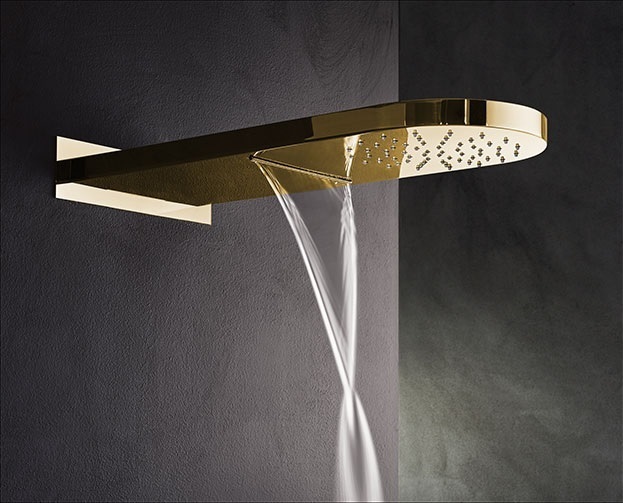How do thermostatic shower valves maintain constant
water temperature despite pressure fluctuations?
Thermostatic shower valves: These valves use a wax or bi-metal thermostat that expands or contracts with temperature changes.
This movement adjusts the mix of hot and cold water, maintaining a constant output temperature despite
pressure fluctuations in the supply lines.
What are the engineering challenges in designing a fully integrated smart shower system?
Smart shower system challenges: Key challenges include waterproofing electronics, creating intuitive user interfaces, ensuring reliability in a humid environment, and integrating with various home systems and IoT platforms

How does water conservation technology in showers impact building plumbing systems?
Water conservation impact on plumbing: Low-flow showers can lead to reduced water velocity in pipes, potentially causing sediment buildup or bacterial growth. Building designers must account for this by adjusting pipe sizes or implementing circulation systems.

What are the hydrodynamic principles behind high-pressure shower heads?
High-pressure showerhead principles: These use principles like the Venturi effect and carefully designed nozzles to increase water velocity. The challenge is balancing high pressure with water conservation requirements.
How do digital shower controls interface with home automation systems?
Digital shower and home automation interface: This typically involves Wi-Fi or Bluetooth connectivity, allowing the shower to communicate with smart home hubs. Challenges include developing robust APIs and ensuring cybersecurity.
What are the technical considerations for installing a steam shower in a residential bathroom?
Steam shower installation considerations: Key factors include proper sealing to prevent moisture escape, adequate ventilation, sloped ceilings for condensation runoff, and appropriate materials that can withstand high humidity and heat.

How do multi-outlet diverter valves manage water flow in complex custom shower systems?
Multi-outlet diverter valves: These use complex internal channels and seals to direct water flow to different outlets. Designing them to maintain consistent pressure across all outlets is a significant challenge.
What are the material science challenges in developing scale-resistant shower components?
Scale-resistant materials: This involves developing surfaces that resist mineral adhesion, often using nanotechnology or hydrophobic coatings. The challenge is creating durable solutions that don't affect water flow.
How do shower water recycling systems work, and what are their limitations?
Shower water recycling systems: These systems capture, filter, and disinfect shower water for reuse. Challenges include effective filtration, maintaining water quality, and integrating with existing plumbing systems.
Browse Featured Selections
What are the acoustical engineering principles behind noise-reducing shower designs?
Noise-reducing shower designs: These involve managing water flow to reduce turbulence, using sound-absorbing materials, and designing shower enclosures to minimize echo. The challenge is balancing noise reduction with shower performance and aesthetics.
How do electromagnetic water softeners affect shower performance?
Answer: Electromagnetic softeners use pulsed electric fields to alter mineral crystal formation, potentially reducing scale buildup. However, their effectiveness in showers is debated, with mixed results on water feel and fixture longevity.
What are the design considerations for creating accessible showers that comply with ADA standards?
Answer: Key factors include zero-threshold entry, grab bars, seat placement, control accessibility, and slip-resistant flooring. Designers must balance safety features with aesthetics and functionality for all users.
How do shower drain systems in multi-story buildings prevent backflow and odors?
Answer: These systems use P-traps, air admittance valves, and sometimes secondary drainage planes. Proper venting and strategic placement of check valves are crucial to prevent issues in high-rise plumbing.
What are the technical challenges in developing shower systems that can operate in zero-gravity environments?
Answer: Space showers must manage water droplets, maintain air quality, and conserve water. Solutions often involve air flows to direct water, specialized nozzles, and closed-loop filtration systems.
How do ultrasonic cleaning technologies in showers work?
Answer: Ultrasonic showers use high-frequency sound waves to create cavitation bubbles that help remove dirt and oils. Challenges include generating sufficient ultrasonic power and ensuring user safety.
What are the engineering principles behind pressure-compensating flow regulators in shower systems?
Answer: These devices use flexible diaphragms or spring-loaded pistons that deform under pressure, maintaining consistent flow rates despite pressure variations. Designing for a wide pressure range while maintaining durability is key.
How do shower water heaters with thermal energy storage systems function?
Answer: These systems store heat in phase-change materials or high-capacity thermal masses. During use, they release stored heat to maintain temperature, potentially reducing energy consumption during peak hours.
What are the technical aspects of integrating chromotherapy (color therapy) into shower systems?
Answer: This involves waterproof LED systems, color-mixing algorithms, and potentially sensors to adjust lighting based on user preferences or physiological responses. Challenges include light diffusion in water and durability of components.
How do self-cleaning shower surfaces work on a molecular level?
Answer: These often use photocatalytic materials like titanium dioxide that, when exposed to light, create reactive particles that break down organic matter. Maintaining effectiveness over time and in varying conditions is a major challenge.
What are the fluid dynamics principles behind rainfall shower heads that mimic natural rain patterns?
Answer: These involve carefully designed water distribution plates, nozzle arrangements, and sometimes air induction to create larger, softer droplets. Balancing authentic rain feel with sufficient water pressure for rinsing is a key challenge.
|